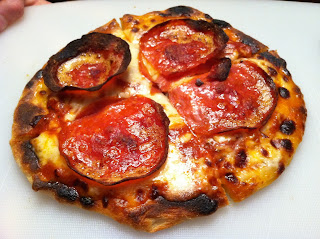I was put in charge of dessert for Christmas dinner so I gathered a list of Christmasy sounding recipes and presented them to the family for an informal poll. Elaine and Axel F narrowed it down to Frozen Peppermint Bouche de Noel and this one. Upon presenting these two final options to mom and dad I received the response: 'the whiskey one. When we see whiskey, we react.' The whiskey one it was.
This recipe is from last December's issue of Bon Appetit magazine. I was skeptical about whether or not a "steamed pudding" would actually be appetizing...luckily it was not only appetizing but really rich, delicious and special enough for Christmas dinner.
Ingredients:
Sauce:
1 cup whole milk
1 cup heavy cream
1 1/3 cup sugar
6 egg yolks
1 vanilla bean
2 tbs whiskey (I may have added extra!)
Puddings:
1 3/4 cup sugar
2 sticks butter (1 cup), at room temp
3/4 cup citrus marmalade*
Zest of one orange
4 large eggs
2/3 cup whiskey**
1 3/4 cup self rising flour***
Special equipment: 8 3/4 cup ramekins, buttered and floured (do this thoroughly, you'll be sorry otherwise!)
To do:
To make the sauce, whisk together egg yolks, milk, heavy cream, sugar and vanilla bean seeds. The recipe said to discard the vanilla bean itself, but I threw it in to impart some additional flavor. Place over medium heat and stir constantly until the mixture thickens and coats the back of a spoon. The recipe said 9 minutes, I cooked it for more like 12-15. It likely depends on whether your ingredients are cold or at room temperature. I was surprised there was no tempering of the yolks situation but this worked out just fine. I did strain mine at the end to get out some lumpy bits at the bottom of the pan. Once done, transfer sauce to a bowl and put in the refrigerator until cool. This can be done up to 2 days in advance.

For the puddings, beat together the sugar and butter until blended and smooth. Add the marmalade and zest and beat again. Beat in the eggs one at a time, then beat in the whiskey and then the flour until combined. Divide the batter equally among the ramekins. I will admit, I only had 6 ramekins and I definitely filled them too full...if you have the prescribed 8, I think you will have better luck in terms of both cooking time (mine took longer than expected) and portion size (these are so rich and mine were definitely too big).
Cover the ramekins with buttered foil (important!) and place in a rack inside a roasting pan. Add hot water to the roasting pan until it comes halfway up the sides of the ramekins. Bring the water to a gentle boil then reduce heat to medium high and cover with foil. Steam the puddings for 50 minutes or until a knife inserted into the center comes out clean. At some point you will think, "these are never going to cook!!" Do not despair, they will, although you may need to turn up the heat and or add additional hot water to the pan.
Once cooked through, carefully remove the ramekins from the roasting pan, run a knife around the edge and turn out onto a plate. Mine came out fairly easily with a minimum or angst and drama, but next time, I will take better care with my butter and flour in the crevices as the caked did stick a bit around the edges. Top with sauce and serve.

This was like a cross between a pudding and a cake, extremely moist but with a tender cake crumb. The bitterness from the whiskey and marmalade is a perfect balance to the super sweet sauce.

*You can use any kind of citrus marmalade...orange is fine. I used one that I made in my jams class at the BCAE that was made from oranges, lemons and limes.
**I used Jameson, you use what you like.
***You will definitely need to use self rising flour, as there no other leavening in the pudding. If you cant find or don't want to purchase a whole sack of the stuff, you can make it yourself by combining 1 1/4 teaspoons Baking powder and 1/4 teaspoon salt to each cup of flour you need.




